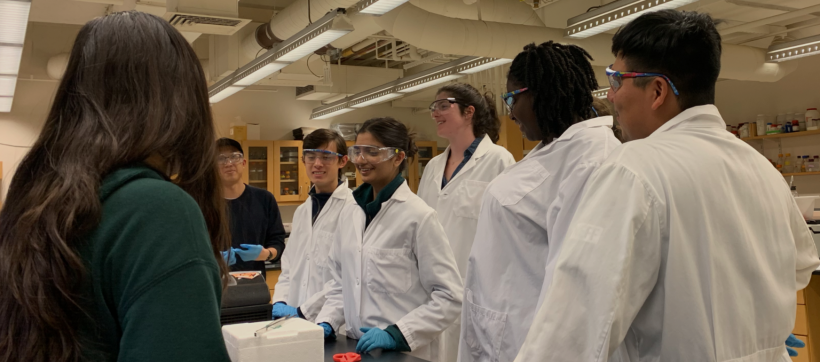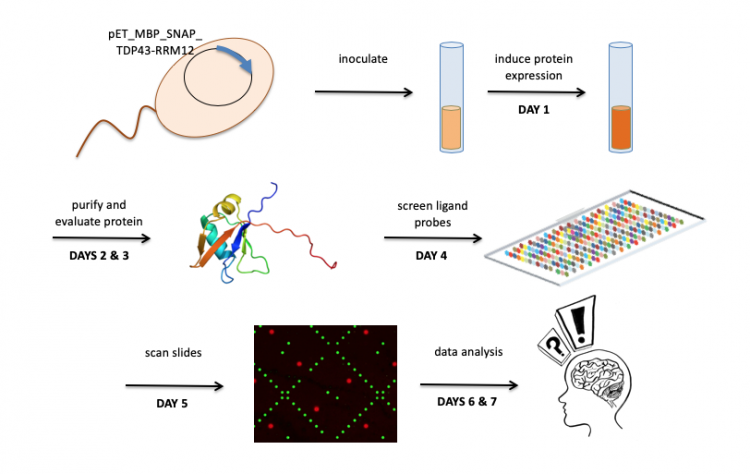Difference between revisions of "20.109(S20):Module 1"
Noreen Lyell (Talk | contribs) (Created page with "<div style="padding: 10px; width: 820px; border: 5px solid #0489B1;"> {{Template:20.109(S20)}}") |
Noreen Lyell (Talk | contribs) |
||
| (5 intermediate revisions by one user not shown) | |||
| Line 1: | Line 1: | ||
<div style="padding: 10px; width: 820px; border: 5px solid #0489B1;"> | <div style="padding: 10px; width: 820px; border: 5px solid #0489B1;"> | ||
{{Template:20.109(S20)}} | {{Template:20.109(S20)}} | ||
| + | |||
| + | |||
| + | =<center>Module 1</center>= | ||
| + | |||
| + | '''Lecturer:''' [http://be.mit.edu/directory/angela-koehler Angela Koehler]<br> | ||
| + | '''Instructors:''' [http://be.mit.edu/directory/noreen-lyell Noreen Lyell], [http://be.mit.edu/directory/leslie-mcclain Leslie McClain], and [http://be.mit.edu/directory/becky-meyer Becky Meyer] <br> | ||
| + | '''TAs:''' Kevin Chung and Joe Kreitz<br> | ||
| + | '''Lab manager:''' Hsinhwa Lee <br> | ||
| + | |||
| + | ==Overview== | ||
| + | Chemical probes, or ligands, are important research tools used to explore cellular processes and therapeutic targets. The use of high-throughput and unbiased strategies to identify small molecules that bind specific biomolecules, such as proteins, can provide insight on the structure or function of targets. Additionally, a small-molecule screen can identify new chemical probes for target proteins of interest. | ||
| + | |||
| + | The small-molecule microarray (SMM) is a high-throughput method that enables the detection of protein-ligand binding. Briefly, ligands are 'printed' onto a slide and incubated with purifed protein. Unbound protein is washed from the slide and bound protein is detected using a tag on the protein of interest. Because the location of every ligand on the slide is known, the detection of protein indicates that it is bound to the ligand at that location. | ||
| + | |||
| + | In your experiment you will use SMM to identify ligands that bind to TDP43, a protein that binds both RNA and DNA. In this, TDP43 has multiple roles in transcriptional repression, pre-mRNA splicing, and translational regulation. More specifically, TDP43 is an important player in nuerodegenerative diseases. | ||
| + | |||
| + | This module has been developed thanks to the generous time and thoughtful efforts of several Koehler Laboratory members, in particular Rob Wilson. | ||
| + | |||
| + | [[Image:Sp20 M1 overview schematic v2.png|thumb|750px|center|]] | ||
| + | |||
| + | <br style="clear:both" /> | ||
| + | |||
| + | ==Lab links: day by day== | ||
| + | M1D1: [[20.109(S20):Complete in silico cloning and induce TDP43 protein expression (Day1) |Complete in silico cloning and induce TDP43 protein expression]]<br> | ||
| + | M1D2: [[20.109(S20):Purify TDP43 protein (Day2) |Purify TDP43 protein]]<br> | ||
| + | M1D3: [[20.109(S20):Assess purity and concentration of TDP43 protein (Day3) | Assess purity and concentration of TDP43 protein]]<br> | ||
| + | M1D4: [[20.109(S20):Perform small molecule microarray (SMM) with TDP43 protein (Day4) |Perform small molecule microarray (SMM) with TDP43 protein]]<br> | ||
| + | M1D5: [[20.109(S20):Scan SMM slides to identify binders of TDP43 protein (Day5) |Scan SMM slides to identify binders of TDP43 protein]]<br> | ||
| + | M1D6: [[20.109(S20):Analyze SMM data (Day6) |Analyze SMM data]]<br> | ||
| + | M1D7: [[20.109(S20):Examine TDP43 binders for chemical features (Day7) |Examine TDP43 binders for chemical features]]<br> | ||
| + | |||
| + | ==Assignments== | ||
| + | [[20.109(S20): Data Summary|Data summary]]<br> | ||
| + | [[20.109(S20): Mini-presentation| Mini-presentation]] <br> | ||
| + | |||
| + | ==References== | ||
| + | |||
| + | *[[Media:Sp17 M1 reference NatProt.pdf| A method for the covalent capture and screening of diverse small molecules in a microarray format.]] ''Nature Protocols.'' 1:2344-2352. | ||
| + | |||
| + | *[[Media:Sp17 M1 reference ChemBiol.pdf| Recent discoveries and applications involving small-molecule microarrays.]] ''Chemical Biology.'' 18:21-28. | ||
| + | |||
| + | ==Notes for teaching faculty== | ||
| + | [[20.109(S20): Prep notes for M1| Prep notes for M1]] | ||
Latest revision as of 16:51, 30 January 2020
Contents
Module 1
Lecturer: Angela Koehler
Instructors: Noreen Lyell, Leslie McClain, and Becky Meyer
TAs: Kevin Chung and Joe Kreitz
Lab manager: Hsinhwa Lee
Overview
Chemical probes, or ligands, are important research tools used to explore cellular processes and therapeutic targets. The use of high-throughput and unbiased strategies to identify small molecules that bind specific biomolecules, such as proteins, can provide insight on the structure or function of targets. Additionally, a small-molecule screen can identify new chemical probes for target proteins of interest.
The small-molecule microarray (SMM) is a high-throughput method that enables the detection of protein-ligand binding. Briefly, ligands are 'printed' onto a slide and incubated with purifed protein. Unbound protein is washed from the slide and bound protein is detected using a tag on the protein of interest. Because the location of every ligand on the slide is known, the detection of protein indicates that it is bound to the ligand at that location.
In your experiment you will use SMM to identify ligands that bind to TDP43, a protein that binds both RNA and DNA. In this, TDP43 has multiple roles in transcriptional repression, pre-mRNA splicing, and translational regulation. More specifically, TDP43 is an important player in nuerodegenerative diseases.
This module has been developed thanks to the generous time and thoughtful efforts of several Koehler Laboratory members, in particular Rob Wilson.
Lab links: day by day
M1D1: Complete in silico cloning and induce TDP43 protein expression
M1D2: Purify TDP43 protein
M1D3: Assess purity and concentration of TDP43 protein
M1D4: Perform small molecule microarray (SMM) with TDP43 protein
M1D5: Scan SMM slides to identify binders of TDP43 protein
M1D6: Analyze SMM data
M1D7: Examine TDP43 binders for chemical features
Assignments
Data summary
Mini-presentation
References
- A method for the covalent capture and screening of diverse small molecules in a microarray format. Nature Protocols. 1:2344-2352.
- Recent discoveries and applications involving small-molecule microarrays. Chemical Biology. 18:21-28.

